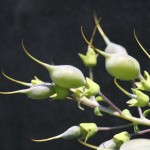Wild Indigo
Baptisia spp.
Fabaceae (Legume family)
Description
Wild Indigo is a deep-rooted, perennial herb with bushy, branched, stout stems (often up to 3/8 inch at the base). Plants of some species may be as tall as 70 inches or 178 cm, but many specimens reach less than 15 inches or 38 cm. The leaves are alternate with three deep lobes and two characteristic oblong structures attached at the base of the leaf stem. Leaves range in shape from slender oblong to rounded oval. They vary in color from blue-green to yellow-green to gray-green. The yellow or white flowers (rarely bluish) are in terminal or split spikes several inches long. In some species, the spikes are erect and in others, they hang like grape clusters. Plants may not bloom until their second or third season of growth. Most species will bloom from March through May. The fruit is a beaked pod containing two or more seeds. The dark gray or black leaf and stem color of the dead plants is a distinguishing feature of Wild Indigo.Habitat
Various species of Wild Indigo are common in north-central and eastern Texas. Texas species extend into Oklahoma, Louisiana, Arkansas, and the eastern United States. They are usually found in sandy or sandy loam soil. Native habitats include woodland edges, limestone glades, and prairies. These species are deer resistant, tolerate heat and humidity, and tolerate drought once established.Toxic Agent
Alkaloids present in Wild Indigo are believed to be responsible for its toxicity. These plants are very unpalatable, and consumption is rare except when the animal is forced to eat it in the hay, as has happened with horses. There are also very infrequent reports of cattle being affected by these plants.Signs of Livestock Ingestion
Signs of poisoning are those of a gastrointestinal upset and include: colic, diarrhea, and, anorexia. In cases submitted to the Texas Veterinary Medical Diagnostic Laboratory, Baptisia-induced colic has been fatal to horses.Management Strategies
Affected animals usually recover with supportive treatment after the contaminated hay has been removed. The black plant material is easily recognized in the hay, which should not be fed in a manner forcing consumption. Examine hay meadows for the plant before harvest. The individual plants can usually be removed mechanically.Images
Plant Characteristics
Flower Color: Blue, White, Yellow
Seed Type: Bean/Pod
Duration: Perennial
Stem Texture: Hairless/Smooth
Growth Habit: Forbs/Broadleaf
Leaf Shape
 : Palmately Compound
: Palmately Compound
Season: Warm
Distribution
 : 01 - Pineywoods, 02 - Gulf Prairies and Marshes, 03 - Post Oak Savannah, 04 - Blackland Prairies, 05 - Cross Timbers and Prairies, 07 - Edwards Plateau, 08 - Rolling Plains
: 01 - Pineywoods, 02 - Gulf Prairies and Marshes, 03 - Post Oak Savannah, 04 - Blackland Prairies, 05 - Cross Timbers and Prairies, 07 - Edwards Plateau, 08 - Rolling Plains
Distributions
Distribution refers to the ecological region in Texas that a plant has been found. You can also view a clickable map.
Book: Toxic Plants of Texas (B-6105)
Collection: Toxics, Wild Flowers
Livestock Affected: Cattle, Horses
Livestock Signs: Abdominal Pain, Anorexia, Colic, Diarrhea






